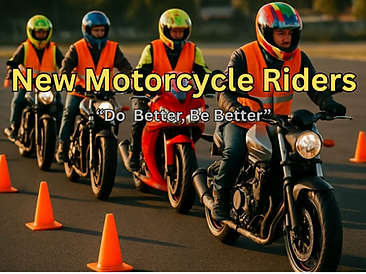Pros and Cons of Using Communication Systems for Motorcycle Training
- NMR
- 1 hour ago
- 3 min read
Learning to ride a motorcycle safely requires clear guidance and real-time feedback. Communication systems, such as Bluetooth headsets or intercom devices, have become popular tools for trainers and learners to stay connected during lessons. These devices allow instructors to give immediate instructions and corrections, which can improve the learning experience. But like any technology, communication systems come with both advantages and drawbacks. This post explores the pros and cons of using communication systems for training motorcyclists to ride.

Advantages of Using Communication Systems in Motorcycle Training
Real-Time Feedback and Guidance
One of the biggest benefits of communication systems is the ability for instructors to provide instant feedback. Instead of waiting for a stop or using hand signals, trainers can speak directly to learners while they ride. This helps correct mistakes immediately, reinforcing good habits and preventing unsafe behaviors from becoming routine.
For example, an instructor can warn a learner about an upcoming turn or remind them to check mirrors without breaking the flow of the lesson. This continuous communication builds confidence and improves skill retention.
Increased Safety During Training
Communication devices enhance safety by keeping the instructor and learner connected at all times. Instructors can alert riders about hazards, traffic conditions, or changes in the training plan. This reduces the risk of accidents caused by miscommunication or delayed instructions.
Additionally, if a learner encounters trouble or feels unsure, they can quickly ask for help without stopping or removing their helmet. This immediate support can prevent panic and maintain focus on the road.
Convenience and Efficiency
Using communication systems makes training sessions more efficient. Instructors don’t need to pull over frequently to give instructions or clarify points. This saves time and allows for longer, more productive rides.
Learners also benefit from clear, uninterrupted guidance, which can speed up the learning process. The ability to communicate hands-free means riders can keep their hands on the controls and eyes on the road, improving overall training quality.
Encourages Better Listening and Focus
When learners hear instructions directly in their helmet, they tend to pay closer attention. The clear audio reduces distractions and helps riders focus on specific tasks. This focused learning environment can lead to faster skill development and better retention of safety practices.
Disadvantages of Using Communication Systems in Motorcycle Training
Potential for Distraction
While communication systems provide valuable guidance, they can also become a source of distraction. Constant talking or background noise may divert a learner’s attention from the road. For beginners, managing riding skills and processing verbal instructions simultaneously can be overwhelming.
In some cases, learners might focus too much on the instructor’s voice and neglect their surroundings, which could increase the risk of accidents.
Technical Issues and Reliability
Communication devices rely on batteries, signal strength, and proper setup. Technical problems such as dropped connections, static noise, or device malfunctions can interrupt communication during critical moments. This can frustrate both instructors and learners and reduce the effectiveness of the training.
Moreover, some systems may have limited range, which restricts movement during lessons. Instructors and learners need to ensure their devices are fully charged and compatible before each session.
Cost and Accessibility
High-quality communication systems can be expensive. For some training schools or individual learners, investing in these devices may not be feasible. Budget constraints might limit access to this technology, especially in regions where motorcycle training resources are already scarce.
Additionally, some riders may find the devices uncomfortable or difficult to use, especially if they are not familiar with Bluetooth technology or helmet integration.
Overreliance on Technology
Relying heavily on communication systems might reduce the development of non-verbal communication skills, such as hand signals and body language, which are essential for safe riding. Instructors and learners should balance the use of technology with traditional training methods to ensure comprehensive skill building.
Practical Tips for Using Communication Systems Effectively
Choose devices designed specifically for motorcycle use, with noise-canceling features and helmet compatibility.
Test the system before each training session to avoid technical disruptions.
Keep verbal instructions clear, concise, and spaced out to prevent information overload.
Encourage learners to practice hand signals and situational awareness alongside using communication devices.
Use communication systems as a supplement, not a replacement, for hands-on training and observation.





.png)